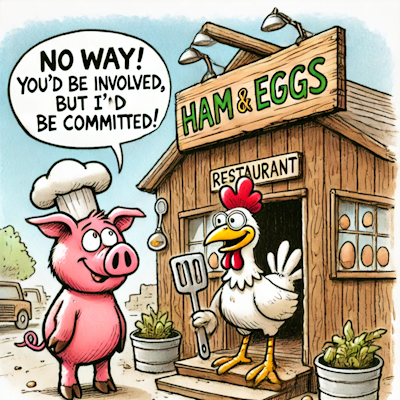Chicken & Pig
Illustrates Commitment vs Involvement in Agile Roles
This parable is often used in Agile circles to distinguish between two types of roles: those who are committed to the work (like the pig), and those who are involved (like the chicken).
In Scrum, for example:
- Pigs (Committed): Team members who are directly responsible for delivering the product. This includes Developers, the Scrum Master, and the Product Owner.
- Chickens (Involved): Stakeholders, managers, customers, and others who provide input or support but are not accountable for delivering Sprint work.
The distinction originally helped teams set boundaries and protect their focus. For instance, in Sprint Planning or Daily Scrum, only committed team members would speak, while involved parties would observe or provide input separately.
This parable was once part of early Scrum Guides, but was removed from the official guide in 2011 to avoid reinforcing exclusion. Still, it remains useful when applied with care to highlight ownership and focus.

One day, a chicken and a pig were strolling through the countryside when the chicken had an idea.
“Hey Pig!” said the chicken. “We should start a restaurant together.”
“Maybe,” said the pig. “What would we call it?”
The chicken beamed. “Ham & Eggs!”
The pig frowned. “No thanks. You'd just be involved. I'd be committed.”
Lessons Learned
Respect the Team's Focus
The pig/chicken metaphor reinforces that delivery teams need space and autonomy. Involving too many "chickens" in daily processes can lead to distractions, pressure, or scope creep.
Clarify Roles and Accountability
Agile thrives on clear ownership. Knowing who is accountable for outcomes helps reduce confusion, duplication of effort, and blame-shifting.
Stakeholder Engagement Still Matters
While chickens aren't committed to daily delivery, their feedback is vital. Agile teams must still create feedback loops with users, business stakeholders, and leadership, especially through Reviews and frequent check-ins.
The Metaphor Has Limits
The Scrum Guide no longer uses this metaphor because it can unintentionally create barriers between teams and stakeholders. Agile is about collaboration, not exclusion. Use the metaphor thoughtfully and clarify that it's about commitment to delivery, not status or importance.
Coaching Tips
- Use the Metaphor Selectively: Don't lead with "chickens & pigs" unless the audience is already familiar with Agile. Introduce it only to explain delivery accountability, and follow up by inviting respectful collaboration.
- Frame it as Ownership, Not Exclusion: Emphasize that “commitment” means responsibility for outcomes, not superiority. Stakeholders are essential partners, even if they're not on the hook for daily delivery.
- Balance Boundaries and Access: Encourage teams to hold focused Scrum events, while creating separate, welcoming channels for stakeholder feedback and questions (e.g., office hours, reviews, roadmap check-ins).
- Model Respectful Curiosity: When stakeholders push into team space, coach both sides to engage with curiosity, not defensiveness. Help them see how structure serves their shared goals.
- Reinforce the Agile Principle of Collaboration: Highlight the Agile Manifesto's call for “business people and developers [to] work together daily.” Don't let the metaphor become a wall, use it to explain the kitchen, then invite everyone to the table.
The Chicken and Pig parable may be lighthearted, but its message cuts to the core of effective Agile teamwork: clarity of commitment. While Scrum no longer uses these labels officially, the distinction still offers a useful lens, so long as it's applied with care. Committed roles must be empowered to make decisions, focus on delivery, and learn through iteration. Involved roles must understand how and when to support without undermining that focus. Respect, collaboration, and clear boundaries make it possible for both to contribute meaningfully.
At its heart, Agile is not about labels but about shared purpose. Teams thrive when everyone understands how they contribute to that purpose, whether they're inside the kitchen or cheering from the dining room.


